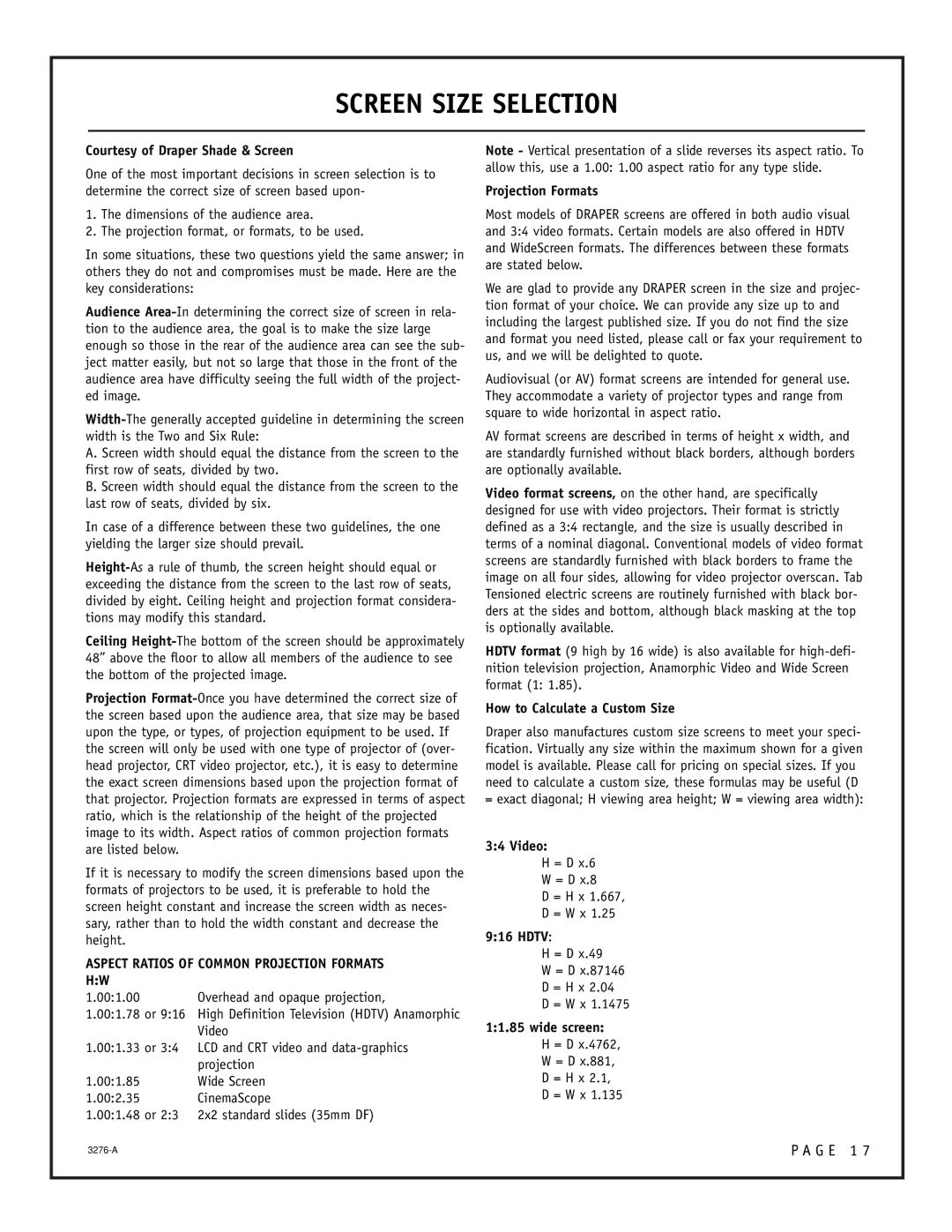
SCREEN SIZE SELECTION
Courtesy of Draper Shade & Screen
One of the most important decisions in screen selection is to determine the correct size of screen based upon-
1.The dimensions of the audience area.
2.The projection format, or formats, to be used.
In some situations, these two questions yield the same answer; in others they do not and compromises must be made. Here are the key considerations:
Audience
A. Screen width should equal the distance from the screen to the first row of seats, divided by two.
B. Screen width should equal the distance from the screen to the last row of seats, divided by six.
In case of a difference between these two guidelines, the one yielding the larger size should prevail.
Ceiling
Projection
If it is necessary to modify the screen dimensions based upon the formats of projectors to be used, it is preferable to hold the screen height constant and increase the screen width as neces- sary, rather than to hold the width constant and decrease the height.
ASPECT RATIOS OF COMMON PROJECTION FORMATS H:W
1.00:1.00 1.00:1.78 or 9:16
1.00:1.33 or 3:4
1.00:1.85
1.00:2.35 1.00:1.48 or 2:3
Note - Vertical presentation of a slide reverses its aspect ratio. To allow this, use a 1.00: 1.00 aspect ratio for any type slide.
Projection Formats
Most models of DRAPER screens are offered in both audio visual and 3:4 video formats. Certain models are also offered in HDTV and WideScreen formats. The differences between these formats are stated below.
We are glad to provide any DRAPER screen in the size and projec- tion format of your choice. We can provide any size up to and including the largest published size. If you do not find the size and format you need listed, please call or fax your requirement to us, and we will be delighted to quote.
Audiovisual (or AV) format screens are intended for general use. They accommodate a variety of projector types and range from square to wide horizontal in aspect ratio.
AV format screens are described in terms of height x width, and are standardly furnished without black borders, although borders are optionally available.
Video format screens, on the other hand, are specifically designed for use with video projectors. Their format is strictly defined as a 3:4 rectangle, and the size is usually described in terms of a nominal diagonal. Conventional models of video format screens are standardly furnished with black borders to frame the image on all four sides, allowing for video projector overscan. Tab Tensioned electric screens are routinely furnished with black bor- ders at the sides and bottom, although black masking at the top is optionally available.
HDTV format (9 high by 16 wide) is also available for
How to Calculate a Custom Size
Draper also manufactures custom size screens to meet your speci- fication. Virtually any size within the maximum shown for a given model is available. Please call for pricing on special sizes. If you need to calculate a custom size, these formulas may be useful (D = exact diagonal; H viewing area height; W = viewing area width):
3:4 Video:
H = D x.6
W = D x.8
D = H x 1.667,
D = W x 1.25
9:16 HDTV:
H = D x.49
W = D x.87146
D = H x 2.04
D = W x 1.1475
1:1.85 wide screen:
H = D x.4762,
W = D x.881,
D = H x 2.1,
D = W x 1.135
P A G E 1 7 |
